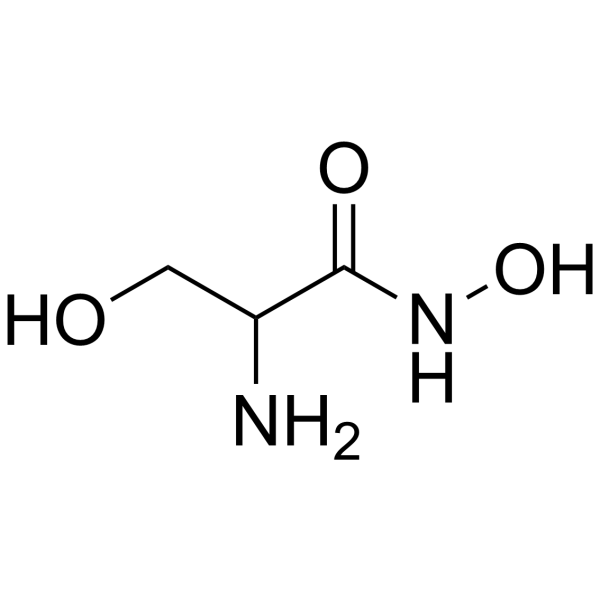DL-Serine hydroxamate

DL-Serine hydroxamate structure
|
Common Name | DL-Serine hydroxamate | ||
|---|---|---|---|---|
| CAS Number | 55779-32-3 | Molecular Weight | 120.10700 | |
| Density | N/A | Boiling Point | N/A | |
| Molecular Formula | C3H8N2O3 | Melting Point | N/A | |
| MSDS | Chinese USA | Flash Point | N/A | |
|
Selective inhibition of divergent seryl-tRNA synthetases by serine analogues.
FEBS Lett. 579(20) , 4344-8, (2005) Seryl-tRNA synthetases (SerRSs) fall into two distinct evolutionary groups of enzymes, bacterial and methanogenic. These two types of SerRSs display only minimal sequence similarity, primarily within the class II conserved motifs, and possess distinct modes o... |
|
|
Genome conformation capture reveals that the Escherichia coli chromosome is organized by replication and transcription.
Nucleic Acids Res. 41(12) , 6058-71, (2013) To fit within the confines of the cell, bacterial chromosomes are highly condensed into a structure called the nucleoid. Despite the high degree of compaction in the nucleoid, the genome remains accessible to essential biological processes, such as replicatio... |
|
|
Serine hydroxamate and the transcriptome of high cell density recombinant Escherichia coli MG1655.
Appl. Biochem. Biotechnol. 157(2) , 124-39, (2009) For more than 30 years, serine hydroxamate has been used to chemically stimulate a stringent response in Escherichia coli and other bacteria. These studies have elucidated numerous characteristics of the classical stringent response beyond the simple cellular... |
|
|
Global gene expression during stringent response in Corynebacterium glutamicum in presence and absence of the rel gene encoding (p)ppGpp synthase.
BMC Genomics 7 , 230, (2006) The stringent response is the initial reaction of microorganisms to nutritional stress. During stringent response the small nucleotides (p)ppGpp act as global regulators and reprogram bacterial transcription. In this work, the genetic network controlled by th... |
|
|
Transcription profiling of the stringent response in Escherichia coli.
J. Bacteriol. 190(3) , 1084-96, (2008) The bacterial stringent response serves as a paradigm for understanding global regulatory processes. It can be triggered by nutrient downshifts or starvation and is characterized by a rapid RelA-dependent increase in the alarmone (p)ppGpp. One hallmark of the... |
|
|
The effect of the stringent response on mutation rates in Escherichia coli K-12.
Mol. Microbiol. 19(2) , 213-9, (1996) The reversion rates of two isogenic Escherichia coli K-12 auxotrophs differing only in relA have been determined in the absence or presence of serine hydroxamate, which provokes the stringent response. Reversion rates of leuB- and argH- were significantly hig... |
|
|
The ObgE/CgtA GTPase influences the stringent response to amino acid starvation in Escherichia coli.
Mol. Microbiol. 73(2) , 253-66, (2009) The stringent response is important for bacterial survival under stressful conditions, such as amino acid starvation, and is characterized by the accumulation of ppGpp and pppGpp. ObgE (CgtA, YhbZ) is an essential conserved GTPase in Escherichia coli and seve... |
|
|
Hydrolysis of non-cognate aminoacyl-adenylates by a class II aminoacyl-tRNA synthetase lacking an editing domain.
FEBS Lett. 581(26) , 5110-4, (2007) Aminoacyl-tRNA synthetases, a group of enzymes catalyzing aminoacyl-tRNA formation, may possess inherent editing activity to clear mistakes arising through the selection of non-cognate amino acid. It is generally assumed that both editing substrates, non-cogn... |
|
|
Identification of promoter and stringent regulation of transcription of the fabH, fabD and fabG genes encoding fatty acid biosynthetic enzymes of Escherichia coli.
Nucleic Acids Res. 24(9) , 1747-52, (1996) In Escherichia coli, amino acid starvation results in the coordinate inhibition of a variety of metabolic activities, including fatty acid and phospholipid biosynthesis. By using primer extension analysis we identified the fabH promoter responsible for transc... |
|
|
Physiological analysis of the stringent response elicited in an extreme thermophilic bacterium, Thermus thermophilus.
J. Bacteriol. 188(20) , 7111-22, (2006) Guanosine tetraphosphate (ppGpp) is a key mediator of stringent control, an adaptive response of bacteria to amino acid starvation, and has thus been termed a bacterial alarmone. Previous X-ray crystallographic analysis has provided a structural basis for the... |